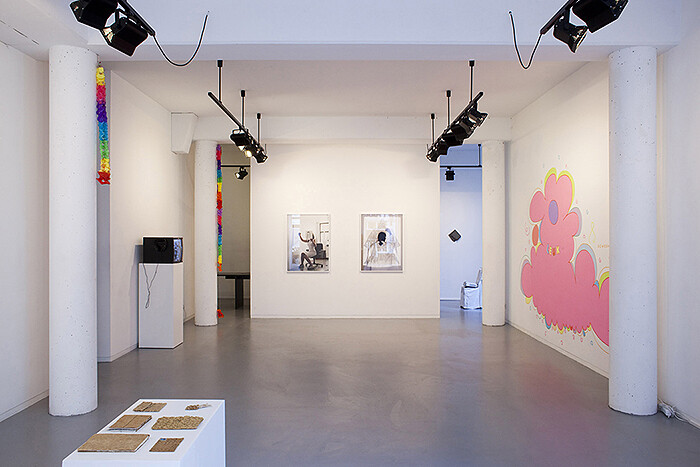When a speech act contradicts what is said, this is called a performative contradiction. In the mid-1970s, the fight for women’s rights found itself in an inconsistency of this kind, when the general logic of gender construction was cast into doubt. By mapping a useless alphabetical order onto kitchen tools, Martha Rosler’s early video performance Semiotics of the Kitchen (1975) points precisely to this shift from a grammar of signs to a post-structuralist awareness of signifiers being unstable and dynamic. As much as Rosler’s performance stakes out a critical and ironic position towards semiotics—translating and subverting it with supposedly “female” everyday practices—its message is by no means limited to feminist issues. Semiotics was the newly contested theoretical terrain between structuralism and post-structuralism, with the sign and the distinction of signifiers at its core.
But a lot has happened in theory, as much as in art, since 1975: the rise of postcolonialism as well as affective, bodily, post-human, and queer perspectives on theories of gender, just to name a few. This is not to say that this exhibition directly addresses feminism, or even feminist discourses. Rather, this multi-generational group show at Stigter van Doesburg captures the subtle and ironic attitude of Rosler’s original piece in the work of nine different artists created over the ensuing decades. Each of these pieces react in one way or another to Rosler’s video performance, and yet they keep up—to a lesser and greater extent—with the discussions of their own time, reflecting a range of attitudes towards feminism.
For a long time, the work of Dutch artist Loes van der Horst (born in 1919) was only recognized as “applied arts” at Amsterdam’s Stedelijk Museum instead of under the classical “male” genres of painting or sculpture. Some of her very rarely available works are shown here (most of her oeuvre and larger conceptual installations were given to the Stedelijk Museum after her death in 2012). Van der Horst’s “Untitled” series (1978)—envelopes and small booklets—are made out of baking paper, a material one might associate with the domestic roles traditionally consigned to women. Irene Fortuyn applies a similar approach to Remains (2002) by purposefully adopting so-called “women’s” materials in her work. However, the decades separating van der Horst’s and Fortuyn’s practice gives Remains a decisively different spin. Fortuyn’s gestures—involving the introduction of textiles, threads, and sewing remnants she has collected between two pieces of glass—may no longer be simply read as a quiet withdrawal, but instead challenge the construction of gender roles in an ironic way.
A similar historical shift can be seen in the self-portraits of Lynn Hershman Leeson and Frances Stark. Both question visual modes of self-depiction, but the works were made at two very different moments in the history of feminist thinking. Hershman Leeson’s Seduction (1984), from the “Phantom Limb” series, engages with the pressure exerted by the imagery of popular culture and the mediated construction of the self. By contrast, in Drawing from a Study of Bobby Jesus (2013), Stark reinvents the genre of self-portraiture. Covering her face with a hand-drawn portrait while drawing second image at the same time, she intertwines the roles of the producer and consumer, spectator and artist within a single image.
Other works in the show do not lend themselves as easily to historical comparison, but instead offer a critique of language or a series of meta-observations. Lily van der Stokker painted a pink cloud on the wall with the Dutch word “leuk” written on it in a children’s book style. “Leuk” shares the same etymological roots with the English word “like” (Facebook’s like-button gets sometimes translated as “leuk-knop”). However, unlike English, gender is implicated in the Dutch expression; according to the gallery attendant, “leuk” is a word rarely used by male speakers, and is more frequently employed by women to name describe something cute. Thus, grasping the significance of this well-liked cloud requires our leaving the field of semiotics far behind, to enter the post-structuralist realm of floating signifiers and a critique of gendered language.
Amalia Pica’s Final de Fiesta (2005) leaves the spectator with signs of a party that is either in its last stages or ended a while ago. In either case, nobody has bothered to remove the remnants of some colorful festoons. There may still be a few last guests hanging out in some corner of the house, but it could also be the final moment of partying altogether, perhaps referring to philosopher Rosi Braidotti’s feminist take on the posthuman “life beyond the self.”1
In this careful selection of works, “Semiotics of the Kitchen. What Happened After” paces savvily across the field of feminist artistic discourses. Although some recent approaches, like postcolonial or queer critique, do not play a significant role in the exhibition, the works on view do demonstrate how the performative contradiction inherent in Rosler’s work—as much as in the theoretical struggles of her time—may be overcome by confronting an inconsistency head on and breaking its deadlock with a playful attitude.
Rosi Braidotti, The Posthuman (Cambridge: Polity Press, 2013), 50–54.








